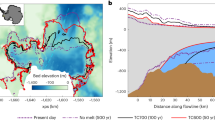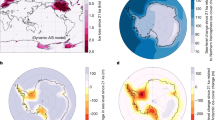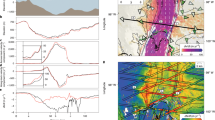Abstract
Over the past 40 years Pine Island Glacier in West Antarctica has thinned at an accelerating rate1,2,3, so that at present it is the largest single contributor to sea-level rise in Antarctica4. In recent years, the grounding line, which separates the grounded ice sheet from the floating ice shelf, has retreated by tens of kilometres5. At present, the grounding line is crossing a retrograde bedrock slope that lies well below sea level, raising the possibility that the glacier is susceptible to the marine ice-sheet instability mechanism6,7,8. Here, using three state-of-the-art ice-flow models9,10,11, we show that Pine Island Glacier’s grounding line is probably engaged in an unstable 40 km retreat. The associated mass loss increases substantially over the course of our simulations from the average value of 20 Gt yr−1 observed for the 1992–2011 period4, up to and above 100 Gt yr−1, equivalent to 3.5–10 mm eustatic sea-level rise over the following 20 years. Mass loss remains elevated from then on, ranging from 60 to 120 Gt yr−1.
This is a preview of subscription content, access via your institution
Access options
Subscribe to this journal
Receive 12 print issues and online access
$209.00 per year
only $17.42 per issue
Buy this article
- Purchase on Springer Link
- Instant access to full article PDF
Prices may be subject to local taxes which are calculated during checkout




Similar content being viewed by others
References
Bindschadler, R. History of lower Pine Island Glacier, West Antarctica, from Landsat imagery. J. Glaciol. 48, 536–544 (2002).
Rignot, E. et al. Recent antarctic ice mass loss from radar interferometry and regional climate modelling. Nature Geosci. 1, 106–110 (2008).
Wingham, D., Wallis, D. & Shepherd, A. Spatial and temporal evolution of Pine Island Glacier thinning, 1995–2006. Geophys. Res. Lett. 36, L17501 (2009).
Shepherd, A. et al. A reconciled estimate of ice-sheet mass balance. Science 338, 1183–1189 (2012).
Park, J., Gourmelen, N., Shepherd, A., Kim, S., Vaughan, D. & Wingham, D. Sustained retreat of Pine Island Glacier. Geophys. Res. Lett. 40, 2137–2142 (2013).
Schoof, C. Ice sheet grounding line dynamics: Steady states, stability, and hysteresis. J. Geophys. Res. 112, F03S28 (2007).
Durand, G., Gagliardini, O., de Fleurian, B., Zwinger, T. & Le Meur, E. Marine ice sheet dynamics: Hysteresis and neutral equilibrium. J. Geophys. Res. 114, F03009 (2009).
Joughin, I., Smith, B. E. & Holland, D. M. Sensitivity of 21st century sea level to ocean-induced thinning of Pine Island Glacier, Antarctica. Geophys. Res. Lett. 37, L20502 (2010).
Favier, L., Gagliardini, O., Durand, G. & Zwinger, T. A three-dimensional full stokes model of the grounding line dynamics: Effect of a pinning point beneath the ice shelf. Cryosphere 6, 101–112 (2012).
Cornford, S. et al. Adaptive mesh, finite volume modeling of marine ice sheets. J. Comput. Phys. 232, 529–549 (2013).
Gudmundsson, G., Krug, J., Durand, G., Favier, L. & Gagliardini, O. The stability of grounding lines on retrograde slopes. The Cryosphere 6, 1497–1505 (2012).
Pritchard, H. et al. Antarctic ice-sheet loss driven by basal melting of ice shelves. Nature 484, 502–505 (2012).
Jacobs, S., Jenkins, A., Giulivi, C. & Dutrieux, P. Stronger ocean circulation and increased melting under Pine Island Glacier ice shelf. Nature Geosci. 4, 519–523 (2011).
Vaughan, D. et al. New boundary conditions for the West Antarctic ice sheet: Subglacial topography beneath Pine Island Glacier. Geophys. Res. Lett. 33, L09501 (2006).
Gladstone, R. M. et al. Calibrated prediction of Pine Island Glacier retreat during the 21st and 22nd centuries with a coupled flowline model. Earth Planet. Sci. Lett. 333, 191–199 (2012).
Pattyn, F. et al. Grounding-line migration in plan-view ice-sheets models: Results of the ice2sea mismip3d intercomparison. J. Glaciol. 59 (215), 410–422 (2013).
Gillet-Chaulet, F. et al. Greenland ice sheet contribution to sea-level rise from a new-generation ice-sheet model. Cryosphere 6, 1561–1576 (2012).
Van de Berg, W., van den Broeke, M., Reijmer, C. & van Meijgaard, E. Reassessment of the antarctic surface mass balance using calibrated output of a regional atmospheric climate model. J. Geophys. Res. 111, D11104 (2006).
Dutrieux, P. et al. Pine Island Glacier ice shelf melt distributed at kilometre scales. The Cryosphere 7, 1543–1555 (2013).
Goldberg, D. et al. Investigation of land ice–ocean interaction with a fully coupled ice-ocean model: 1. Model description and behaviour. J. Geophys. Res. 117, F02037 (2012).
Payne, A. J. et al. Numerical modeling of ocean–ice interactions under Pine Island Bay’s ice shelf. J. Geophys. Res. 112, C10019 (2007).
Schoof, C. & Hindmarsh, R. Thin-film flows with wall slip: An asymptotic analysis of higher order glacier flow models. Q. J. Mech. Appl. Math. 63, 73–114 (2010).
MacAyeal, D. Large-scale ice flow over a viscous basal sediment-theory and application to ice stream B, Antarctica. J. Geophys. Res. 94, 4071–4087 (1989).
Le Brocq, A., Payne, A. & Vieli, A. An improved Antarctic dataset for high resolution numerical ice sheet models (ALBMAP v1). Earth Syst. Sci. Data 2, 247–260 (2010).
Pattyn, F. Antarctic subglacial conditions inferred from a hybrid ice sheet/ice stream model. Earth Planet. Sci. Lett. 295, 451–461 (2010).
Rignot, E., Mouginot, J. & Scheuchl, B. Ice flow of the Antarctic ice sheet. Science 333, 1427–1430 (2011).
Timmermann, R. et al. A consistent data set of Antarctic ice sheet topography, cavity geometry, and global bathymetry. Earth Syst. Sci. Data 2, 261–273 (2010).
Ligtenberg, S., Helsen, M. & van den Broeke, M. An improved semi- empirical model for the densification of Antarctic firn. The Cryosphere 5, 809–819 (2011).
Joughin, I. et al. Basal conditions for Pine Island and Thwaites Glaciers, West Antarctica, determined using satellite and airborne data. J. Glaciol. 55, 245–257 (2009).
Lenaerts, J., van den Broeke, M., van de Berg, W. J., van Meijgaard, E. & Kuipers Munneke, P. A new, high-resolution surface mass balance map of Antarctica (1979–2010) based on regional atmospheric climate modeling. Geophys. Res. Lett. 39, L04501 (2012).
Acknowledgements
We are grateful to T. Flament for observations of surface elevation change, A. Shepherd and N. Gourmelen for recent location of the grounding line and P. Dutrieux for discussions on sub-ice-shelf melting. Elmer/Ice computations were carried out using HPC resources from GENCI-CINES (grant/2012016066/) and from the Service Commun de Calcul Intensif de l’Observatoire de Grenoble (SCCI). BISICLES calculations were carried out on the University of Bristol’s Blue Crystal Phase 2 supercomputer and the code is jointly developed with D. F. Martin at Lawrence Berkeley National Laboratory, California, USA, with financial support provided by the US Department of Energy and the UK Natural Environment Research Council. This work was supported by financial support from the ice2sea program from the European Union 7th Framework Programme, grant number 226375, ice2sea contribution number 157 and by NERC grant number NE/H02333X/1.
Author information
Authors and Affiliations
Contributions
L.F. and G.D. designed the experiments. L.F. did the numerical modelling with Elmer/Ice, S.L.C. with BISICLES and G.H.G. with Úa. O.G., F.G-C. and T.Z. contributed to the set-up of Elmer/Ice, A.J.P. contributed to BISICLES. A.M.L.B. provided the high-resolution topographic input data set that has been used by Elmer/Ice and BISICLES. L.F., G.D. and S.L.C. led the writing of the manuscript, which has been improved by all authors.
Corresponding author
Ethics declarations
Competing interests
The authors declare no competing financial interests.
Supplementary information
Rights and permissions
About this article
Cite this article
Favier, L., Durand, G., Cornford, S. et al. Retreat of Pine Island Glacier controlled by marine ice-sheet instability. Nature Clim Change 4, 117–121 (2014). https://doi.org/10.1038/nclimate2094
Received:
Accepted:
Published:
Issue Date:
DOI: https://doi.org/10.1038/nclimate2094
This article is cited by
-
Recent irreversible retreat phase of Pine Island Glacier
Nature Climate Change (2024)
-
The variation in basal channels and basal melt rates of Pine Island Ice Shelf
Acta Oceanologica Sinica (2024)
-
A thicker Antarctic ice stream during the mid-Pliocene warm period
Communications Earth & Environment (2023)
-
Climate intervention on a high-emissions pathway could delay but not prevent West Antarctic Ice Sheet demise
Nature Climate Change (2023)
-
Sea level rise from West Antarctic mass loss significantly modified by large snowfall anomalies
Nature Communications (2023)



